Mowing and Wildlife
Managing Open Space for Wildlife Species
Many property owners want clean-cut, attractive lawns or fields. However, what appears to be a healthy lawn to property owners isn’t necessarily the best option for wildlife. In fact, continual mowing can reduce or remove valuable habitat and discourage many wildlife species from visiting a landowner’s property. However, when properly used, mowing can be a useful habitat management tool.
Key Facts for Wildlife-Friendly Mowing
Realistic goals must be considered for any habitat management practice, including mowing. If you are targeting a particular species, the species must occur – or potentially occur – at the desired location, based on it’s habitat requirements, life cycle, and distribution. After determining that a target species may occur on your property, several considerations should be kept in mind when deciding if you should mow and at what time you should apply this habitat management practice. For instance, mowing during spring and summer months may reduce or even kill nesting and young animals, such as eastern meadowlarks, bobwhite quail, ring-necked pheasants, rabbits and deer. The uncut areas allow the young animals to hide from predators, and provide seasonal forage and thermal cover.
Mowing to control “weeds” also may not be beneficial for some wildlife. Although controlling problem plants such as thistles and Ailanthas is important, many “weeds,” including nettles, foxtail and ragweed, are palatable to wildlife or attract insects needed to meet the diet requirements of many bird species. The trick is providing a balance between volunteer forbs (weeds) and other desirable plants. However, without some management, foxtail and other persistent plants can dominate grass stands and reduce diversity. In addition, some weedy-looking tall grasses, such as Indiangrass, switchgrass, big and little bluestems, broom sedge, Canada wild rye, and Virginia wild rye are actually native grasses.
Native grasses grow in clumps and are used to reestablish native grasslands in Pennsylvania under programs such as the Conservation Reserve Program (CRP) and the Conservation Reserve Enhancement Program (CREP). These native grasses provide excellent year round cover and forage for wildlife, while retaining enough bare ground areas for animals to move through the field in search of food. Still, to maintain the existence of a native grass field, occasional disturbance from mowing, burning, spraying, or disking is needed. Without mowing or other disturbances, succession will take place, and your grassland will be replaced by woody vegetation. Subsequently, wildlife requiring grassland or meadow habitat will be replaced by more common woodland wildlife. Mowing in cycles and pattern mowing are beneficial management alternatives for wildlife that rely on grasslands. These techniques involve cutting different blocks of meadow or grassland each year on a two to five year cycle. Mowing in cycles creates habitat with different-aged, diverse vegetation and deters the growth of trees and shrubs, thus preserving your grassland.
| Giant Foxtail | Switchgrass |
|---|
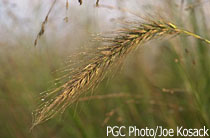
Giant Foxtail |
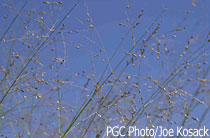
Switchgrass |
Common Wildlife Nesting Periods:
White-tailed deer - May 15th to July 15th
Eastern cottontail rabbits - February 1st to September 30th
Wild turkeys - April 15th to July 31st
Bobwhite quail - April 15th to July 31st
Ring-necked pheasant - April 15th to June 30th
Grassland songbirds: - Average (June 1st to August 15th)
- Eastern meadowlark - May 15th to July 31st
- Grasshopper sparrow - June 1st to August 15th
- Field sparrow - May 15th to August 15th
- Bobolink - May 15th to June 30th
- Dickcissel - June 1st to July 31st
Mowing Considerations
When, why, where, and how to mow should be considered before using mowing to manage wildlife habitat.
When to Mow
To maximize wildlife benefits and reduce wildlife mortality, mowing should be done outside of the nesting and brood-rearing season, which generally occurs from April to August. Late summer and late winter are the best times to mow for wildlife.
Cool season grasses and forages (Canada wild rye, Virginia wild rye, orchardgrass, timothy, clovers, etc.) should be left uncut every other year to improve soil, cover, and forage conditions for wildlife. When managed for premium hay production, cool season grasses are often cut during the nesting season. A balance between habitat and hay production is achieved when harvest occurs in late May. At this time, cool season grasses are highly nutritious, resulting in quality hay. As a wildlife benefit, mowing in late May allows some regrowth to occur prior to peak nesting season.
Compared to cool season grasses, native warm season grasses (switchgrass, big and little bluestems, indiangrass, etc.) mature later in the growing season. This allows the grasses to be mowed after the peak nesting season. Mowing for native warm season grasses should occur from August 1 to August 15 to allow enough regrowth for winter cover. Mowing warm season grasses at this time also allows grasses to build energy reserves necessary for hearty regrowth in the spring.
Old field areas experiencing woody encroachment should be mowed during late winter (February or early March) or early fall (September) to maintain food and cover for wildlife. The key, as with grasses, is to avoid mowing during the prime nesting and brood-rearing periods.
Reasons for Mowing
Reasons to mow:
- To maintain or enhance wildlife habitat.
- To maintain grasslands and meadows.
- To suppress the growth of noxious weed species such as Canada thistle and multiflora rose.
- To remove browning cool season grasses in the late summer and stimulate the growth of warm season grasses and flowers that provide wildlife food and cover for the remainder of the year.
- To prepare land for other land management practices, such as applying herbicides, prescribed burning, and seeding.
- If local zoning ordinances require a specific lawn length and the management of “weeds.”
Reasons not to mow:
- Mowing is expensive. Fuel costs are high, and equipment must be repaired and maintai3 ed.
- Continuous mowing has little value for wildlife. Areas not mowed frequently provide excellent habitat for wildlife to nest, raise young, and forage.
- Grasses with shallow roots cannot uptake nutrients or prevent erosion as well as grasses that are deeply rooted.
- Mowing takes time.
- Mowing adds pollutants to the air.
- Frequent mowing creates thatch buildup, resulting in undesirable groundcover conditions.
Where to mow...
Yards or Lawns (less than 1 acre)
Maintaining grass at a height of at least three inches and setting aside other areas of the yard for wildlife-friendly plantings (e.g. black-eyed Susan, red clover, alders, viburnums, dogwoods, etc.) will enhance wildlife habitat and wildlife feeding areas. However, some urban and suburban jurisdictions restrict lawn length and the presence of “weeds.” You should check with your local zoning board and adhere to mowing requirements if they exist or propose changing them to benefit wildlife.
Fallow Fields, Grasslands, and Maintaining Existing Cover
To keep valuable grasses from being overtaken by competition, mow one-third of a field once a year in succession, rotating sections of the opening so each is mowed every third year. Mowing should be performed outside of wildlife nesting periods (mid August). This allows nesting wildlife such as cottontails and quail to mature during the spring and summer with minimal disturbance. Mowing height is also critical. Native grasses should not be cut below 10 inches. Cutting these grasses too low many damage or kill them, because the grasses store much of their energy at their bases. Also, cutting at a minimum height of 10 inches, provides some wildlife cover until regrowth of the plant canopy can occur.
Split the desired mowing location into three strips. Mow one strip the first year, a different strip the next year, and the last unmowed strip the next year. This will create diverse vegetation stands with differing age structures, which will provide food and cover for many wildlife species. It will also keep woody stems small enough to be mowed. When possible, grasses should be baled to remove thatch from the field and prevent buildup at ground level.
For Weed Suppression
Weeds can be described as unwanted or undesirable vegetation. What may be a “weed” in your lawn or garden might not be a weed in a field for wildlife. Some weeds, like ragweed are actually desired by wildlife for food and attract insect food sources, while other noxious weeds are not and compete with more wildlife-friendly vegetation. Spot mowing in problem areas while the weeds are flowering may help control noxious species such as Canada thistle and multiflora rose, while minimizing negative impacts to wildlife. Mowing at this time for weed suppression works by stopping seed production. However, controlling these problem species will probably require additional herbicide treatments or physical removal.
For Haying
Many options exist for landowners who need some hay, but still want to help wildlife. Cutting forage grasses or legumes at the peak of production may be compatible with wildlife habitat value. Mowing times are dependent on the type of forage being used for hay. Native grasses should be cut during the early seedhead stage, when their nutritional content is greatest. To make harvesting more efficient, consider squaring off fields and leaving the odd spaces unmowed until August or leaving a 30-ft border along wooded areas or fence rows. These areas are often less productive for hay, dry slowly, or have fallen branches that damage haying equipment. However, these field borders are valuable to wildlife. Mowing cool season grasses at their boot stage in May minimizes the effects of mowing on most nesting wildlife by allowing some regrowth prior to the peak nesting season (June-July). If cool season grasses are clipped as a first cut during June and July, nests may be destroyed, young wildlife may be killed, and the hay quality will be lower. Warm season grasses (such as Indiangrass, switchgrass, Eastern gamagrass, etc.) grow largely during the mid to late summer (July-August) and provide excellent food and year-round cover for wildlife. Since their peak growth does not usually occur until after the nesting season, mowing warm season grasses is usually less of an issue for wildlife and should take place between August 1 and August 15. Native warm season grasses should be cut to a minimum of 10 inches, and you should allow regrowth of 10-12 inches before the first killing frost. This new growth, following a late summer cutting, will provide adequate winter cover for grassland wildlife.
Roadsides, Ditches, and Field Edges
These areas provide important nesting and foraging areas for birds, small mammals, deer and insects. Wildlife habitat can be enhanced along roadsides by reduced mowing, delayed mowing, planting native grasses, and mowing at a higher height. Contrary to popular belief, mowing more than 10 feet along roadsides does not significantly reduce mortality of wildlife on roads.
Mowing should be limited along roadsides, ditches, and field edges. By limiting how often designated areas are mowed, you allow vegetation to attain optimal height for wildlife habitat. Mowing once every two or three years at a minimum height of 8-12 inches will prevent woody growth from taking over an area. Mowing along roadsides should occur in late summer (August 1-31) to allow most nesting birds and small mammals to successfully rear their young. Countless nests and young are destroyed if mowing occurs earlier in the year, and most equipment operators are unaware of the high number of nests that are destroyed while they are mowing.
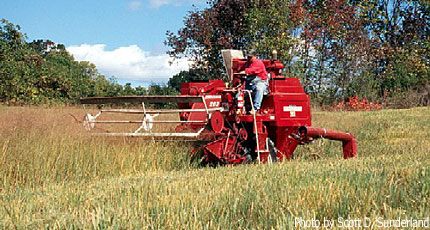
Harvesting seed from warm season grasses
Types of Mowing:
There are three main types of mowing: block mowing, strip mowing, and random pattern mowing. Block mowing is performed by dividing long, narrow fields into three or four blocks and mowing the blocks on a an annual rotational mowing cycle. Strip mowing is accomplished by dividing a field into strips that are at fixed or variable widths. Rotate mowed and unmowed strips, but do not strip mow the same area each year. On the other hand, random pattern mowing is done by randomly mowing sections of a field into irregularly-shaped patterns of cut and uncut vegetation cover. Fields should be rotationally mowed in a three- to five- year cycle to reduce the encroachment of woody vegetation. Whatever type or pattern you use for mowing, you should avoid leaving unmowed cover strips too narrow (less than 100 feet wide) or too small (less than a half-acre). Blocks or strips that are too small or narrow can serve as habitat sinks, making it easier for predators to hunt small animals that you may be trying to benefit by your habitat management objectives.
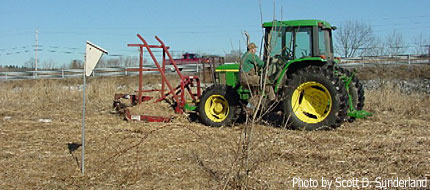
Mowing young trees and brush in a native grass field
Alternatives to Mowing
For controlling noxious weeds and woody plant invasion on grass stands, the preferred alternative to mowing is spot spraying with selective herbicides. During the establishment period of grass stands, invasive vegetation can encroach into grasslands. The use of selective herbicides before and after grass/legume plantings can help control noxious weeds and establish a successful grass stand. Random or strip spraying may be performed throughout the year, so long as the established grass stand is not damaged. Random or strip herbicide spraying is performed by spraying random patches or fixed strips within a field. Controlling invasives in grass stands is more economical and effective if outbreaks are treated at first detection. APPLY ALL HERBICIDES ACCORDING TO THE LABEL!
Another alternative to mowing is strip or rotational disking. Disking is a simple, effective, and inexpensive wildlife habitat management tool. In strip disking, a disk or harrow is used to create ground disturbance and set back natural succession by breaking up grassy vegetation. Disking opens up grass stands, reduces thick mats of grass, stimulates germination of seed-producing plants, and increases insect populations as a wildlife food source.
Controlled burning also should be considered as an alternative to mowing, especially when managing many larger fields. Controlled fire sets back natural succession and stimulates growth of valuable grasses and legumes, by releasing nutrients. Controlled burning is less expensive and time consuming than mowing, and produces many wildlife and forage benefits. However, controlled burning requires careful planning and controlled conditions to be an effective management tool.
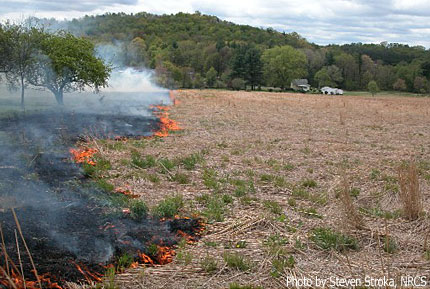
Controlled burn of native grasses
If you carefully examine where, when, why, and how mowing should be implemented on your property, mowing can be a simple and effective way to manage young forest/overgown field habitats that are beneficial to wildlife!